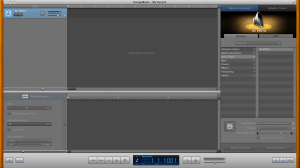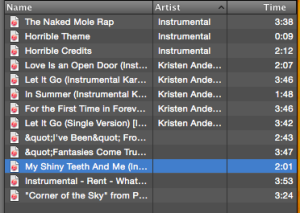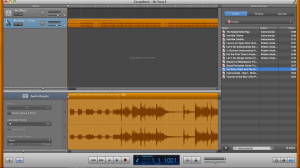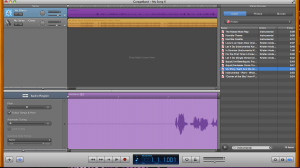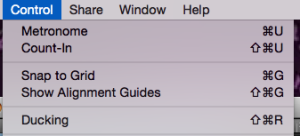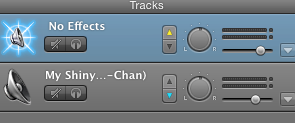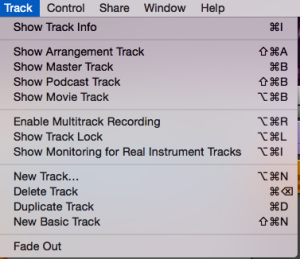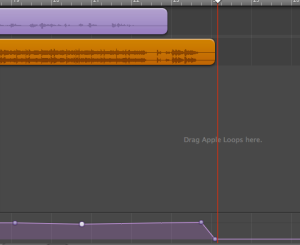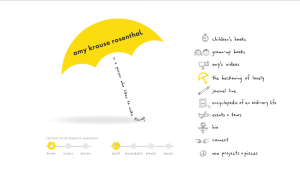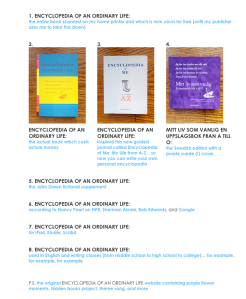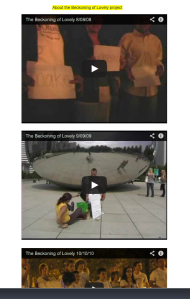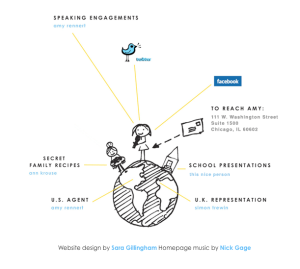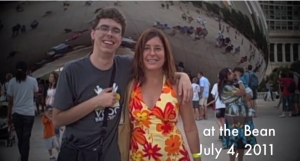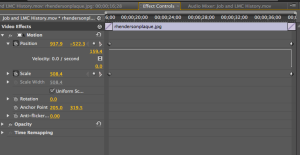This has probably been one of my favorite classes at Pitt. An extremely open and creative space where almost nothing we could do was wrong, but everything was up for criticism. I’ve always thought of myself as a very creative person, so this class was very intriguing to me and it didn’t disappoint; I made great projects and better friends. I was very very happy with my video portrait project, I enjoyed knowing what shots I would get and how it would all fit together into the final product. Same goes for my photo essay. I knew I wanted it to be based around my boyfriend’s family somehow but I didn’t know in what way until me and him started discussing it. I knew right away it should be on his mother and all in all I’m proud of the work I did for that. I didn’t expect it to come together nearly as quickly as it did, and I enjoyed putting the pieces in place. I think I’m most proud of my sound project, not just because I was able to get Rob Paulsen for an interview, but because through his influence sound has become my most familiar medium, so I’m much more used to working with sound than nearly anything else. The website’s given me the most trouble, but as someone who’s never coded in his life, one could hopefully sympathize. This class has taught me so much about the value of information and how challenging it is to effectively get it out there into the world.
Author: wayfan
Wanna Sound a Bit More Like Ira Glass?
Here, I show my setup in GarageBand (vers. 6.0.5) and how incredibly easy it is to duck background music into the folds of an audio piece, no manual volume adjusting required! I just open up a new Voice project in GarageBand…
Import my background music by clicking the bottom right music note and selecting it from the list (a karaoke from The Fairly Oddparents because childhood)…
Drag the music file into the grey project box on the left of the screen…
Record some voiceover on top…
When both pieces are in your window, go up to Control and click Ducking.
Arrows will pop up in the near the titles in the left panel. Click the up arrow on the track you want to hear over the music (in this case, my voice track). All other arrows will automatically show blue down arrows unless you adjust them.
(Apologies, I don’t seem to be able to actually post the audio, so Trisha, I’ll show it to you after class tomorrow if you want.)
I also added a Fade Out to the end of the music track, which is as easy as going up to the Track menu, clicking Fade Out, and adjusting where you want the fade to take place.
No Sing-Along Blog This Time
I felt rather sure that there would be some mention of Joss Whedon’s now-cult-classic Wickedesque tale of misunderstood villainy Dr. Horrible’s Sing-Along Blog during this episode of This American Life. Sadly, this was not to be, but the stories it did feature were very much worth the wait. Sonically, the whole piece is just bursting with music and voices and situations that kept me hooked the whole time and never left me bored. I was surprised that I’d heard of a number of people associated with this episode besides Ira Glass himself; John Hodgman I’d known as an author, comedian, and frequent collaborator of indie-rock band They Might Be Giants. I actually own Building Stories, the Chris Ware book mentioned at the very end of the podcast, and it’s an outstanding piece of work in its own right.
All of this is of course small potatoes to how all these people and more fit together to tell several very cohesive stories. As others have mentioned, I love how it started out with interviews of several people, winding its way to one-on-one perspective pieces, and finally the ending act delivered as essentially a monologue or one-act play. The music I felt, did add some feeling and emotions (how do you not feel badass listening to the Superman theme?) as well as some of the interstitial bits, particularly the quote from The Powerpuff Girls, as I loved that show growing up, so it really hit a nostalgic nerve for me. The interview with Zora I found very fascinating as it used almost no music; nothing but voices and ambient sound effects I found this extremely useful in that it let me picture exactly the warrior princess this woman dreamed of being, as well as focus on each of her life goals and paths that it took without having to think too long on any one in particular. I will definitely take away, much like our films, the power of silence as a large part of what can make audio great. As a working voice actor myself, usually working with nothing but my own voice, it’s a medium I’m already comfortable with but eager to keep exploring.
Who is Amy KR?
I found one of my favorite little hidden gems of a site, one that hardly anyone I’ve met knows about because they don’t follow specific authors as I do. This is website of Chicago-based children’s author, novelist, filmmaker, and general creator Amy Krouse Rosenthal, at http://www.whoisamy.com.
Her site is beautifully minimalistic, using only white and yellow as its main colors. On the home page, you can change how the yellow umbrella (a rather signature prop of Amy’s) can be shown: for a rainy day (open), sunny (closed), or windy (blown inside out with the letters flying off). You can also change the music or calming noises you hear as you browse the site.
Amy has plenty of pages devoted to her various genres of books, such as her autobiography in the form of an encyclopedia below. With links to buy all her books for children or adults, she makes her site extremely easy to navigate, and it’s fun just to click each page and see what each one holds.
Amy’s most famous project has been an ongoing film called The Beckoning of Lovely. Having gone viral on YouTube, its first filmed endeavor was as an event on 8/8/08 at 8:08pm at Chicago’s famous bean-shaped sculpture, Cloud Gate, where Amy and several hundred strangers met and “made a bunch of stuff together”. This giant spontaneous collaboration of talented gifts, beautiful people and small good deeds inspired Amy to go further and create the first completely user-generated feature film. She took ideas and submission from people all over the world, as well as continued to make YouTube videos every year on 9/9/09, 10/10/10. etc, which are all stored at the appropriate page on her website.
Amy has long been an inspiration to many people, including myself, and I was lucky enough to be at Cloud Gate for Independence Day 2011 and got to meet her and her family. She was a wonderfully reflective and wise person, and her site shows that in spades. Even the contact page is made up of a globe, connecting everyone around the world to a woman who can truly bring people together in a way I’ve never seen before or since.
Elliot Halpern – Video Portrait
My finished documentary!
The Endless Garage
This photo from “The Ruins of Detroit” really stuck with me. It’s a long shot of the dilapidated, abandoned remains of the Fisher Body car dealership (now a small part of General Motors). The first thing I noticed was the color in relation to the photos around it. Most of the other pictures in this photo essay were grey shades and splashes of color, fading or muted with the passage of time. This photo immediately stands out from those with its almost turquoise hue permeating the entire photo.
Through the whole space, bricks and detritus have crumbled to the ground in misshapen hills and piles, and exposed pipes and wires hang from the ceiling. The garage seems to stretch on for miles in the left foreground even though we can clearly see the window at the far end. This impressive use of perspective is done in such a way that our eyes are immediately drawn from the pile of bricks and rubble on the ground to the small light down that long passage, as if giving us a literal light at the end of the tunnel, a glimmer of hope for the future of the city.
I’ve always loved photos or videos taken from abandoned buildings, and to see one in such a state of decay and ruin is not only enlightening, but humbling. Who knows where Pittsburgh will be in ten or twenty years? Could it look anything like Detroit looks now? I hope not, but you never know. This photo tells a very powerful story considering that at one point Fisher was an extremely popular car, and now since the company went belly-up, hundreds of people went home jobless and the metal of millions of cars went to the scrap heap. This photo is the story of a ghost town that used to be one of the most burgeoning places in the country.
Video Portrait of Elliot Halpern (Rough)
Sorry this took me so long! VERY rough draft, but I’m happy with it so far!
Be Ken Burns in Adobe Premiere
For one shot of my documentary, I wanted to take a photograph and pan up it for some nice B-roll footage. I was completely unsure of how to do this until I messed around with some of the parameters in the Effect Controls panel.
Load your picture into the Project Panel (on the left) and drop it where you want to use it in your video, A- or B-roll. Double click it so it fills up your Effect Controls panel (in the middle). Bring down the Motion drop-down and select the animation for “Position”. Double click the picture in the playback window (on the right) and text box-like sliders will appear. Drag the picture down to the bottom, so it’s in the same position as mine.
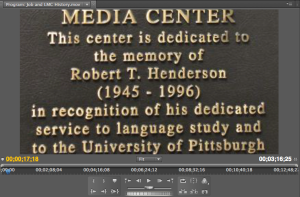
Once it’s in place, put a keyframe at the start of your mini-timeline in the Effect Control panel to tell that this is where you want your shot to start.
Drag upwards on your picture until you reach the top, as shown here.
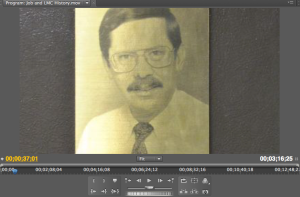
Add another keyframe at the end of your mini-timeline to show that this is where you want your shot to stop.
Your Effect Control panel should now look something like this:
Press space and see your pan in acton!
A Brief Reflection on John Baldessari
My absolute favorite of the films we watched was the portrait of artist John Baldessari. The draws of this film for me were the use of shots of everyday objects belonging to the artist and the infusion of its narrator, the gravelly-voiced crooner of all things banal and macabre, Tom Waits. I’ve been a fan of Waits for many years, and the fact that he and Baldessari have a sort of conversation (“He’s got a great voice!” “Thanks, John.”) in the midst of the former narrating the latter’s life and accomplishments is one of the many highlights of the film. Waits’ distinctive snarl on words like “Biennale”, and undertone of “Jesus Christ” accompanying rapid shots of Baldessari’s bevy of awards lends an amount of humor to this short that would never have been there had someone other than Waits narrated. As a voice actor myself, this is one of the many reasons I love hearing just the right voice for a spot, and Waits was a brilliant pick for this.
While there is some discussion of Baldessari’s current life, we don’t see modern-day John that often, and when we do it’s nearly always in a medium or a close-up shot from across his enormous desk. This helps us feel both the immensity of his workspace and the kind of intimate closeness that only Baldessari’s friends, family, and work itself have likely seen. Of course, that intimacy also comes in other forms; giving the audience a very personal look at Baldessari’s office and personal life, directors Henry Joost and Ariel Schulman go so far as to shoot close-ups of objects as mundane as his coffee machine, and as private as his Wi-Fi password. (I also enjoyed seeing the hand-drawn thank you note from SpongeBob SquarePants creator Stephen Hillenburg.)
Much of the film is made up of archival footage of Baldessari’s work, be it films or pictures of his paintings, and almost all of Wait’s dialogue is accompanied verbatim and in real time by written words in various formats on the screen. (The use of iconic orchestral music like Rossini’s William Tell Overture provide a perfect and almost frantically joyous backdrop to the pictures, so caught up in the act of helping tell John’s story that they make the documentary feel much shorter than its six-minute runtime and hold the audiences’ attention for much longer.)
Waits’ booze-soaked voice echoes dramatically at the end, quoting Baldessari: “I will not make any more boring art!” for an ending to a film that is fast-paced and full of close-ups, giving us a look at man whose life has been nothing but.
When is Archiving Too Much?
Larsen’s photo not taken fits in perfectly with Derrida’s theory: the “new dynamic” that both her and her subject’s paths take is in direct correlation with Derrida’s archive “producing as well as recording”. This also gels nicely with Wood’s idea of preserving all time for all time.
I’ve very much enjoyed reading these articles on archiving. My family this summer had several revelations about our genealogy, and almost all of them were because of the use of various archival records, be they books, maps, or the Internet. A “photo not taken” scenario figured in as well: There was a house built by our ancestors that was actually in the area, but no one in any book or map had taken a photo of the front or provided a detailed description or address of where it was located, and we eventually had to find it ourselves.
The mere fact that I am able to trace my lineage directly back to Charlemagne (I’m his 42nd great-grandson) shows me how useful and informative archives and records can be. However, take into account that it could also be dangerous to hold so much information for such a long period of time. Could Wood have been wrong about the lifespan of maps and archives? Every photo not taken, every map not drawn, and every archive not recorded could probably be said to be full of things we don’t know – and maybe that’s for the better sometimes.
On the one hand, it’s fascinating to have windows to the past, like the video that went viral a few years ago of an elderly man on the 50’s game show I’ve Got a Secret, being the last living person at the time to have seen the assassination of Abraham Lincoln. On the other, those windows hold immeasurable power and significance, as the US government found out when the Iraqi archives were destroyed. Where should the line be drawn?
